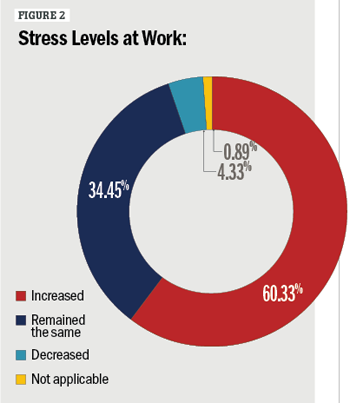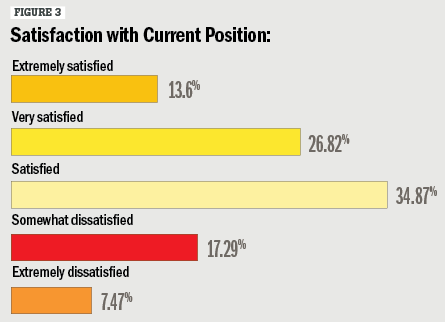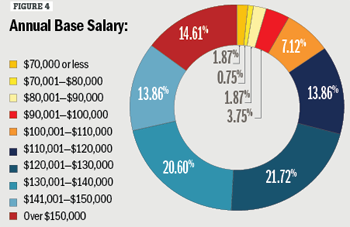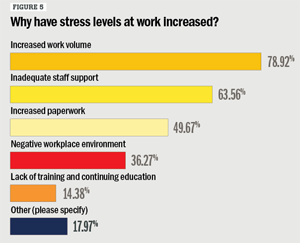The Drug Topics 2017 Pharmacist Salary Survey
As pharmacist salaries rise, so do demands.
The good news is that the majority of pharmacists got a pay raise in 2017, but it came with a downside: a rise in stress levels.
That’s the bottom line from an exclusive Drug Topics' 2017 Salary Survey. More than half of pharmacists who responded to the survey reported receiving a raise this year. Although the salary increases weren’t huge (86.7% reported receiving a raise of 3% or less), every little bit helps when it comes to paying off student debt, buying a house, or starting an independent practice.

That’s the good news. The bad news is that two out of three of respondents said their workload has increased over the past year. About 60% said their stress levels at work went up. (See Figures 1 and 2.)
No practice setting is immune from stress. “Pharmacy is getting busier, more stress on pharmacists is what I hear from my colleagues,” said Alex Bertram, PharmD. He is the only pharmacist in the only pharmacy in a rural town in Ohio. “A lot of push, push, push for more prescriptions because margins are shrinking and you need more volume to make up for the disappearing margins.”
For the independent pharmacist, pressure starts with the mechanism that reimburses a growing proportion of prescriptions below cost. And in many small pharmacies, most business is at the pharmacy counter, not the front end.
On the professional side, there is too much to do and not enough time to get it all done, even in an independent pharmacy with no direct competition, like Bertam’s pharmacy.
At his pharmacy, the pressures are at a pretty steady volume that he said he could handle without too much stress. “The problem is I want to do so much more with patients. I want to do more MTM, more vaccinations, more counseling, more patient interaction. And since I’m the only pharmacist around, almost all of my day is checking and verifying prescriptions,” Bertram said. “My biggest stress is not being able to do the things I want to do as a pharmacist, the things I am trained to do as a pharmacist. Instead, I end up doing the things I have to do just to get through the day.”
Click here to find out how 2017 compares to 2016
Stress, or at least job demands that can lead to stress, is built into pharmacy and the rest of health-care. But the nature of the stress changes depending on practice setting.

When Drug Topics talked with pharmacists who volunteered to share their responses, we found that chain and big box pharmacists were the least satisfied.
Kevin Gossett, PharmD, described big box pharmacy as a pressure cooker. “Pharmacy is the highest stress job out there,” he said. “You have pressures from your customers, pressures from corporate, pressures from payers, pressures from every direction. Even the staff pressures you. Like most pharmacists, if I had known before I started pharmacy school what I know now, I would not do it again.”
Up next: Stress, challenges, and job satisfaction
At the other end of the spectrum is Lisetta Fain, RPh, a counseling pharmacist in a small but growing specialty pharmacy. She spends most of her work time on the phone with patients and prescribers.
“I’ve worked in a lot of practice environments, everything from retail to hospital, adult residential care, a PBM, hospice, hospital, and more,” she said. “Pharmacy can be as stressful as you let it be.” Fain works directly with patients, all day, every day, she said.
Related article: The Top 10 Worst States to Be a Pharmacist
“Yes, we get busy, there are days the only time I’m not talking is when I go to the ladies’ room or lunch. There are only two pharmacists and we could do with less pressure. But I know I’m making a difference when I talk with a patient. Of all the pharmacy settings I’ve worked in, this is the one where I have the most direct impact on patient’s lives.”
“One of the major frustrations for independents is PBMs and DIR fees and a reimbursement model that doesn’t work well,” said Kari Shanard-Koenders, RPh, Executive Director of the South Dakota Board of Pharmacy. “Chain pharmacists have the frustration of being in a chain with quotas for vaccinations, DIR, and just about everything else that can be quantified. Hospital pharmacists are, for the most part, extremely happy because they have so much patient contact.”

The 2017 Salary Survey questionnaire was emailed to Drug Topics subscribers in mid-August. More than 1,100 readers responded. The largest group of respondents, 41.5%, are staff pharmacists, followed by pharmacy managers at 16.2%, clinical pharmacists at 12%, supervising pharmacist at 8.6%, and independent owner/partner at 5.3%.
In broad terms, the 2017 responses were similar to those from 2016 and from the last ten years.
Just over half of respondents have more than 25 years of experience, a percentage that is not too dissimilar from the 69% who reported more than 21 years on the job in 2011. Slightly over half of respondents reported working between 40 and 44 hours per week this year. Back in 2008, respondents logged an average of 44.1 hours per week.
Attitudes and Compensation
“Attitudes have been fairly uniform over the past few years,” Shanard-Koenders said. “I’m not hearing a ton of people, outside of state employees, complaining that they don’t make enough. You always have pharmacists who just do the job and those who are very invested and want the very best for their patients. There has always been that combination of attitudes.”

The consistency of those attitudes speaks more to the continuing dedication of pharmacists than to a consistent pharmacy environment. (See Figure 3.)
The average base salary for pharmacists topped $100,000 for the first time in 2007. In 2017, 70% of respondents took home at least $120,000 annually and 14.6% earned more than $150,000. (See Figure 4.)
While more than half of pharmacists reported getting a raise last year, this is a drop from past years. In 2008, 88% reported a raise and 90% expected a raise the next year. Only 58.5% of this year’s respondents expect a raise in 2018.
Total compensation has also changed. In 2017, 43% of pharmacists received additional income such as bonuses, commissions, and profit-sharing, but 43.2% reported receiving an additional $2,500 or less. In 2008, more than half of respondents, 55%, reported additional income and the average add-on was $5,766.
The gap is even larger for pharmacists starting a new job. In 2017, fewer than 20% of respondents started a new job and only 2.6% reported getting a sign-on bonus. The 2008 survey did not show what percentage of pharmacists took a new position, but of those who did, 67% reported a sign-on bonus for an average of $8,000, 33% got relocation expenses, and 3% got a new car that year.
Why the change? It may be because there are more pharmacists today than there are pharmacy jobs.
“Ten year ago, there was a shortage of pharmacists,” Bertram said. “Now that we have so many pharmacy schools popping up there are too many pharmacists.”

Slipping Job Satisfaction
Job satisfaction is also slipping. In 2008, 9% of respondents said that they were extremely satisfied with their current position, 31% very satisfied, and 41% satisfied, a total of 81%. In 2017, those numbers decreased. (See Figure 3).
On the unhappy side, 17 % of respondents said they were somewhat dissatisfied in 2008 and 2% were extremely dissatisfied. In 2017, 17.4% were somewhat dissatisfied and 7.5% extremely dissatisfied.
This may be due to the number of new pharmacists as well. “Before the pharmacy school boom, the pressure was from pharmacists on employers,” Gossett said. “We were almost completely autonomous and we made our own decisions. But with the expansion of pharmacy schools flooding the market with new pharmacists, corporate has the upper hand. We have to come into line with every demand or they find a replacement. There are a lot of underemployed and unemployed pharmacists out there.”
More Stress
The sources of job stress haven’t changed over the years. Back in 2008, 60% of respondents said their job-related stress level was up, almost identical to the 60.3% who reported increased job stress in 2017.

What’s pushing blood pressure higher? Figure 5 shows the most commonly cited reasons.
Increased technology support was a stressor for a third of pharmacists in 2008, but didn’t even make the list this year. Stressors four, five, and six for 2017 were negative workplace environment, lack of training and continuing education, and the catch-all category, “other.”
In “other,” respondents cited many problem areas, including poor management, company red tape, insurers and PBMs, new software, age discrimination, staffing cuts, DEA regulations, enforcing narcotic use restrictions, electronic medical records and electronic medication administration records, pressure to sell more immunizations, reductions in work hours, increases in work hours, and more.
Dealing with the Challenges
“Stress is a matter of how you deal with the challenges that are presented to you,” said Phil Burgess, RPh, DPh, principal of Phil Burgess Consulting, former Operations Director for Walgreens, and member of the Illinois State Board of Pharmacy.
“Challenges and pressures are part of the job. They always have been. How you deal with those challenges and pressures that come at you is what produces stress or not.”
Creating a good support staff is key to reducing stress. Training technicians and letting them do their job can go a long way to easing pressures on the pharmacist, Burgess added. Some pharmacy schools do a good job of training pharmacists to train and guide their support staff, but some pharmacists have to learn it on the job.
Read more: Balancing Act: Dealing with Stress in the Pharmacy
“If the pharmacist is hanging on the phone trying to find out why a copay didn’t go through, the pharmacist has a problem,” he said. “One of the techs should be doing that, not the pharmacist. The pharmacist can be the one who has to explain the problem to the patient, but calling to get the information is a technician function. It’s all about training your support personnel and letting them work to the top of their function so you can be a better pharmacist.”